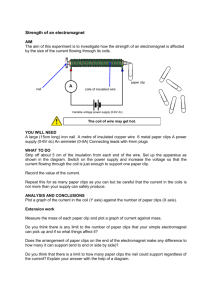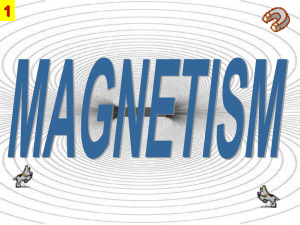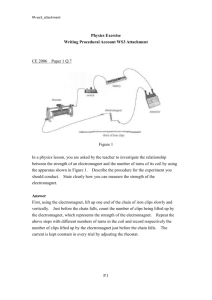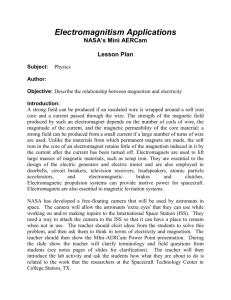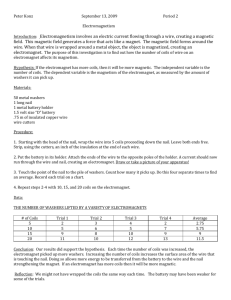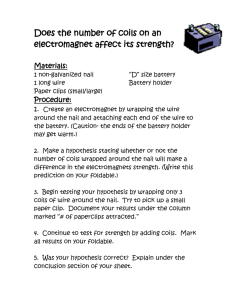Electromagnetic Pick-up
advertisement
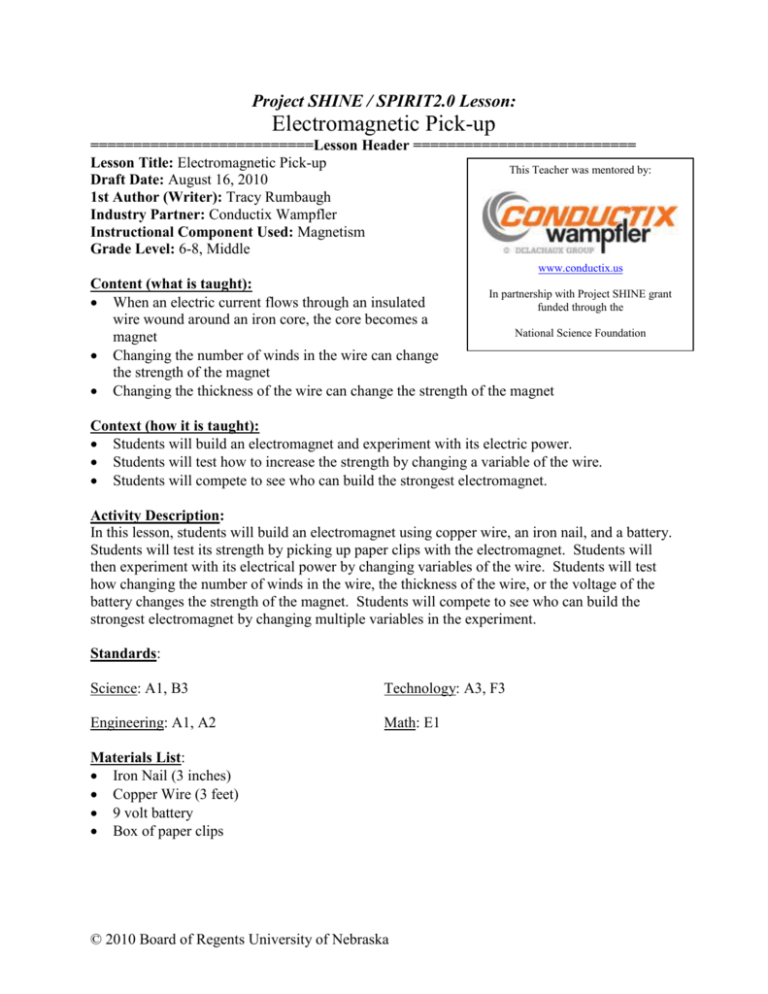
Project SHINE / SPIRIT2.0 Lesson: Electromagnetic Pick-up ==========================Lesson Header ========================== Lesson Title: Electromagnetic Pick-up This Teacher was mentored by: Draft Date: August 16, 2010 1st Author (Writer): Tracy Rumbaugh Industry Partner: Conductix Wampfler Instructional Component Used: Magnetism Grade Level: 6-8, Middle www.conductix.us Content (what is taught): In partnership with Project SHINE grant When an electric current flows through an insulated funded through the wire wound around an iron core, the core becomes a National Science Foundation magnet Changing the number of winds in the wire can change the strength of the magnet Changing the thickness of the wire can change the strength of the magnet Context (how it is taught): Students will build an electromagnet and experiment with its electric power. Students will test how to increase the strength by changing a variable of the wire. Students will compete to see who can build the strongest electromagnet. Activity Description: In this lesson, students will build an electromagnet using copper wire, an iron nail, and a battery. Students will test its strength by picking up paper clips with the electromagnet. Students will then experiment with its electrical power by changing variables of the wire. Students will test how changing the number of winds in the wire, the thickness of the wire, or the voltage of the battery changes the strength of the magnet. Students will compete to see who can build the strongest electromagnet by changing multiple variables in the experiment. Standards: Science: A1, B3 Technology: A3, F3 Engineering: A1, A2 Math: E1 Materials List: Iron Nail (3 inches) Copper Wire (3 feet) 9 volt battery Box of paper clips © 2010 Board of Regents University of Nebraska Asking Questions: (Electromagnetic Pick-Up) Summary: Students will see how electromagnets are used in everyday life. Outline: Show a short video clip of a junkyard crane picking up and dumping off pieces of metal Read articles on common uses of electromagnets Activity: The teacher will show a short video clip of a junkyard crane picking up and dumping off pieces of metal. Students will then be given two articles to read. Students will highlight common uses of electromagnets while they read. Show students the materials needed for building an electromagnet. Give students time to try to figure out the procedure on their own. The teacher may make suggestions where needed. Questions What are electromagnets and how are they used? How does an electromagnet work? What variables could you change to increase the strength of your electromagnet? Answers Electromagnets are used to move things. Electromagnets can also be used to store information. Electric current running through a wire creates a magnetic field. You could change the number of coils in the wire, the thickness of the wire, or the voltage of the battery. Resources: Video Clip of Junkyard Crane (You Tube – Electromagnetic Crane Car): http://www.youtube.com/watch?v=nvyL5s6hLjk&feature=related Examples of How Electromagnets are Used in Everyday Life: http://www.ehow.com/about_4703546_what-electromagnets-used-everyday-life.html http://www.buzzle.com/articles/uses-of-electromagnets-what-are-electromagnets-used-for.html © 2010 Board of Regents University of Nebraska Exploring Concepts: (Electromagnetic Pick-Up) Summary: Students will build an electromagnet and experiment with its electric power. Outline: Students will use their materials to build an electromagnet Students will test its strength by picking up paper clips with the electromagnet Activity: In this lesson, students will use their material to build an electromagnet. The teacher will give students time to try to figure it out on their own using knowledge from the pre-lab reading and discussion. Teacher will make suggestions and give support where needed. The teacher will give students a picture diagram of the electromagnet assembly if needed. Students will then test the strength of the electromagnet by picking up paper clips. To provide formative assessment of the exploration ask you students these questions: How many paper clips will your electromagnet hold? Unhook one of the wires from the battery. Will your electromagnet pick up a paper clip now? What do you need flowing through the wire to make the iron nail magnetic? How can you make your electromagnet stronger? What variable can you change? © 2010 Board of Regents University of Nebraska Instructing Concepts: (Electromagnetic Pick-Up) Magnetism Putting “Magnetism” in Recognizable Terms: Magnetism is the product of attractive and repulsive forces by a material (usually cobalt, nickel, or iron). Attractive and repulsive forces (magnetism) can also be generated by electrical currents or electrically charged particles. Putting “Magnetism” in Conceptual Terms: Magnetism is created by the opposite poles of the magnet, commonly called the North Pole and South Pole. If you have two magnets, opposite poles will attract and the same poles will repel. Around each magnet is a magnetic field the size and strength of which is determined by the strength of the magnet. It is the magnetic fields surrounding magnets that attract and repel. Magnetic fields can also be created by electric charges in motion such as a wire carrying an electric current. Putting “Magnetism” in Process Terms: Magnetism is a force that can be exploited for human use. Magnets and the magnetic fields generated by them are integral components of all electronic devices, medical applications, and may be used to reduce friction. Some monorail trains for example, use repulsive magnetism to lift the train from the surface of the rail. As clean energy and efficiency become more important in the future, magnetism will play an increasingly more important role in technological development. Putting “Magnetism” in Applicable Terms: The simplest application of magnetism is the common compass as it orients itself to earth’s magnetic field allowing the user to find magnetic north. Magnetism is used to create electricity and is a staple in much of the technology we use everyday. © 2010 Board of Regents University of Nebraska Organizing Learning: (Electromagnetic Pick-Up) Summary: Students will investigate how to increase the strength of an electromagnet by changing a variable of the wire. Outline: Students will choose one variable and experiment how changing the variable changes the strength of the electromagnet Students may change either the number of coils in the wire, the thickness of the wire, or the voltage of the battery Activity: In this lesson, students will design and test the strength of an electromagnet. Students choose one variable to test. Students will set up the experiment. The teacher should stress the importance of multiple trials and fair tests. Next, the variable that they are testing should be modified, the tests run again, and the results recorded. Finally, a hypothesis about what they learned should be made and tested by changing the variable and retesting. After the experiment, the results will be presented to the class. Variable to test Change made © 2010 Board of Regents University of Nebraska Observations Comments Understanding Learning: (Electromagnetic Pick-Up) Summary: Students will compete to build the most powerful electromagnetic. They will also answer quiz questions relating to magnetism. Outline: Formative assessment of magnetism Summative assessment of magnetism Activity: Students will be assessed on magnetism by completing quiz questions and a performance assessment. Formative Assessment As students are engaged in the lesson ask these or similar questions: 1) Does the number of times you wrap the wire around the nail affect the strength of the magnet? 2) Does the thickness or length of the wire affect the strength of the magnet? 3) Does the voltage of the battery affect the strength of the magnet? Summative Assessment Students can answer the following quiz questions concerning magnetism. 1) What happened to the strength of the electromagnet when more coils of wire were used? 2) What happened to the strength of the electromagnet when more volts were used? 3) What happened to the strength of the electromagnet when thicker wire was used? 4) Of the three variables tested, which one had the greatest affect on the strength of the electromagnet? 5) Where can you find electromagnets in your home? 6) Describe one way you can apply this knowledge to a real-life situation. Students can have a competition to produce the strongest electromagnet. From classroom supplies of wire, different metals, different sizes of batteries, etc., groups of students will create an electromagnet. The magnets will be tested to see how many paperclips it can pickup. After the test each group will write a lab write-up explaining what happened and how the magnet could be improved if the group had any materials that they wanted. © 2010 Board of Regents University of Nebraska

